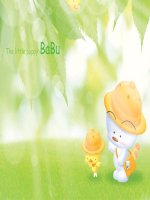Anh 10, Unit 13- reading
Bạn đang xem bản rút gọn của tài liệu. Xem và tải ngay bản đầy đủ của tài liệu tại đây (295.91 KB, 22 trang )
LOVE STORIES
FILM
WAR FILM
COMEDIES FILM
CARTOON FILM
DETECTIVE FILM
SCIENCE FICTION
FILM
ACTION FILM
CINEMA
COMEDIES
FILM
LOVE STORIES
FILM
DETECTIVE
FILM
SCIENCE
FICTION FILM
ACTION
FILM
WAR
FILM
CARTOON
FILM
1. Before you read
Ask and answer questions
1. Have you seen these films? And where?
2. Do you want to see a film at the cinema or on TV?
Why?
3. What kind of films do you like to see? Why?
Adjectives to describe films nowadays and films
in the past:
FILMS YEARS AGO
-
Short
-
Unnatural
-
Boring
-
Black and white
-
Silent
FILMS NOWSADAY
-
Long
-
Natural
-
Interesting
-
Colorful
-
Spoken
Pre-teach vocabulary
- motion(n): the act of moving (chuyển động)
-
Set st in motion: move st
(làm cái gì đó chuyển động)
-
Still (a): silent (yên tĩnh, yên lặng, câm)
-
Audience (n): viewer (người xem, khán giả)
-
Spread (v): to extend over a place (mở rộng, lan ra)
-
Replace (V): thay thế
Grammar structure:
•
Form:
It is/ was not until + phrase/ clause +
that +S + V + O
•
Use: Được dùng để nhấn mạnh thời điểm bắt đầu
Eg: It ‘s not until midday that he leaves.
WHILE YOU READ
•
TASK 1: First reading
Find the word in the passage that can match with
the definition on the right column
Task 1:
1. (n)
2. (n)
3. (n)
4. (Adv)
5. (n)
6. (n)
-Film- making industry
- Series of related events or
actions
-
A period of ten years
-
Quickly and in a short
time
-
Part of film
-
A person in film
Task 1: Answers
1. cinema
2. sequence
3. decade
4. rapidly
5. scene
6. character
- Film- making industry
- Series of related events or
actions
-
A period of ten years
-
Quickly and in a short time
-
Part of film
-
A person in film
Task 2
•
Students read the passage again and
answer the questions:
•
Read through the six questions to
understand them and underline the key
words
1. When did the history of cinema begin?
2. What did scientists discover at that time?
3. Did films in the early days have sound?
4. When were audiences able to see long films?
5. When was sound introduced?
6. What form of films appeared as the old silent film
were being replaced by spoken ones?
1. When did the history of cinema begin?
In the early 19
th
century (line 1)
2. What did scientists discover at that time?
They discovered that when a sequence of still
pictures was set in motion, they could give the
feelings of movement. (line 2. 3)
3. Did films in the early days have sound?
No, they didn’t. (line 13,15)
4. When were audiences able to see long films?
In the early 1910s. (line 9)
5. When was sound introduced?
At the end of the 1920s (line 14)
6. What form of films appeared as the old silent film were
being replaced by spoken ones?
The musical cinema
Task 3
* Read the passage one more time and
find the most suitable for it.
Techniques:
•
Read the option A, B, C and find out the
differences between them.
•
Read the first and the last sentence to decide the
main idea
•
Answer: B
Homework
•
Write a summary of the passage
using the notes taken for the
After you read
Thank you for
your listening!









